Nelle E. Peters Thematic Historic District (Literary Block)
Introduction
Text-to-speech Audio
Commonly referenced as the “Literary Block,” the apartment buildings in this locally-designated historic district were each designed by prolific Kansas City architect Nelle E. Peters and given names that refer to artists and works of literature. The buildings are named Cezanne, Cottesbrook, David Copperfield, Rosseau, Vanity Fair, and Washington Irving. As part of a larger group of buildings, these six apartments were accepted into the Kansas City Register of Historic Places on August 27, 1989, for their unified yet stylistic variety. These six buildings were designed by Nelle E. Peters between 1927 and 1929 using Spanish Colonial and Tudor motifs. Peters reached the height of her career in the 1920s as Kansas City’s population began growing rapidly. Today, she is known for her designs of apartments and hotels, and her influential work creating large multi-family dwellings with highly efficient floorplans. Peters' architectural legacy can still be seen throughout Kansas City and the Midwest with structures like the Luzier Cosmetic Company Building and Tulsa's Ambassador Hotel.
Images
A photo of the David Copperfield Apartment c.1927
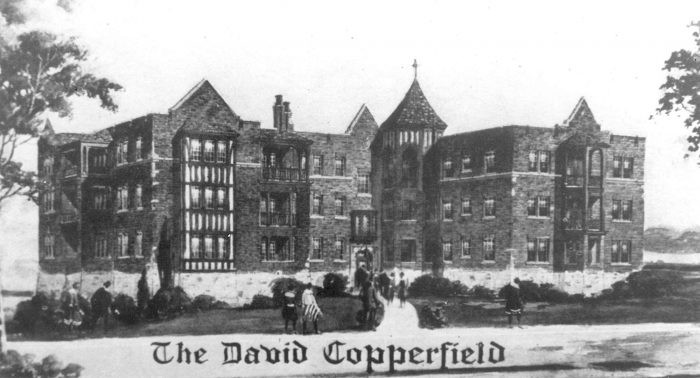
The Cottesbrook Apartments feature two prominent, projecting bays that contain porches. Also note the detail around the buildings entrance.
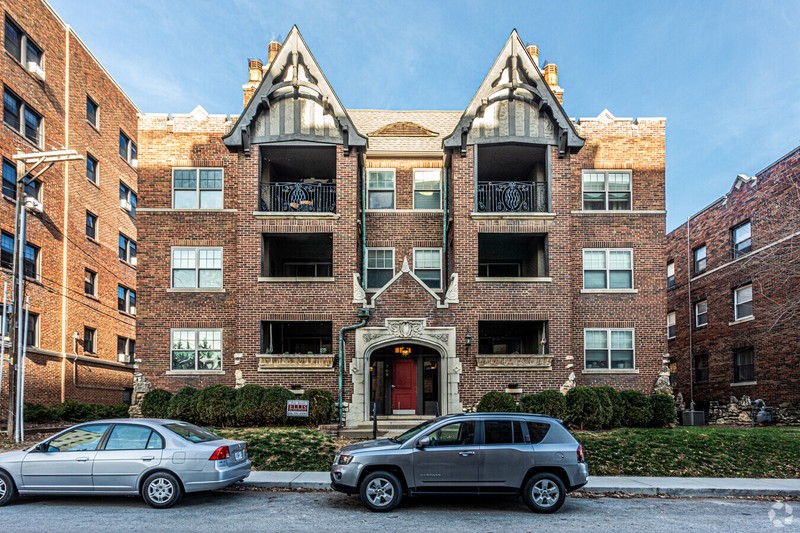
The Cezanne and Rosseau Apartment buildings modified "L" shape surrounds a shared courtyard, one of Nelle Peters commonly used features.
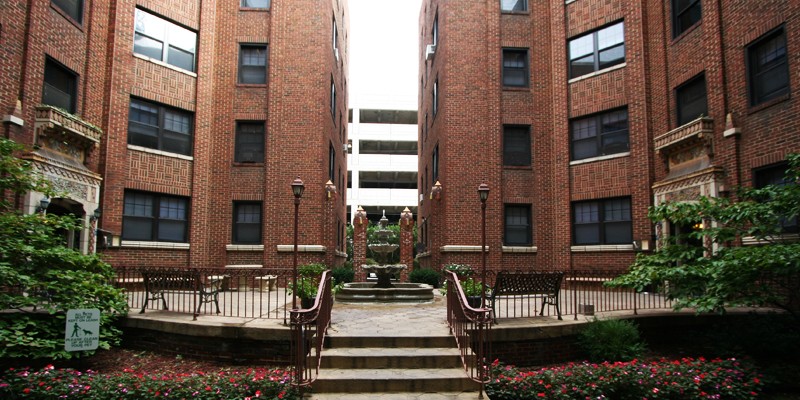
The Cezanne Apartment features detailed terracotta ornamentation around the entrance. Courtesy of Missouri Valley Special Collections, Kansas City Public Library.

An advertisement for the "New Just Completed" Rosseau Apartments c.1929

The entrance to the Washington Irving apartment features ornate detail and spiral columns. Courtesy of Missouri Valley Special Collections, Kansas City Public Library.

Vanity Fair Apartment Building

Sanborn map containing Thematic District apartments - Volume 6, number 796, 1917-1945. Courtesy of Missouri Valley Special Collections, Kansas City Public Library

Sanborn map containing Thematic District apartments - Volume 6, number 797, 1917-1945. Courtesy of Missouri Valley Special Collections, Kansas City Public Library.

Portrait of prolific Kansas City architect Nelle. E. Peters
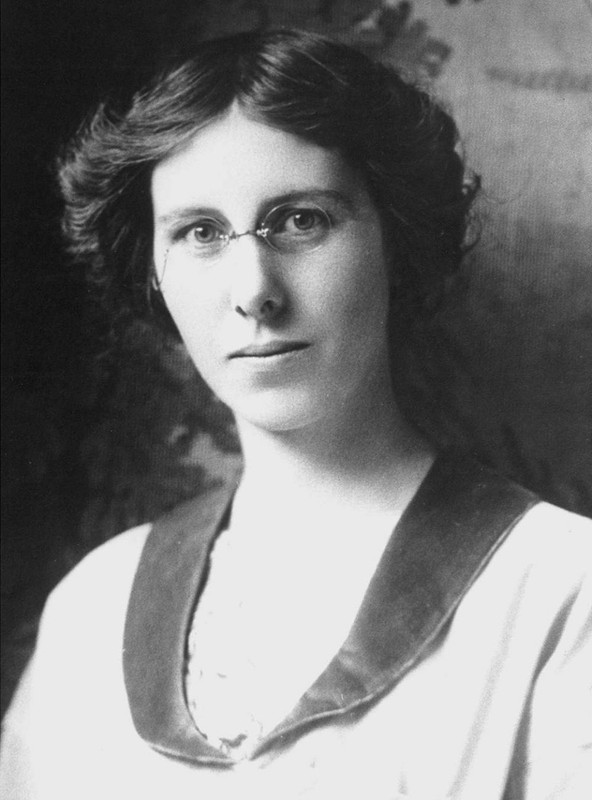
The set of three Peters' Summit Street apartments in process of demolition after being voted down for historic nomination.
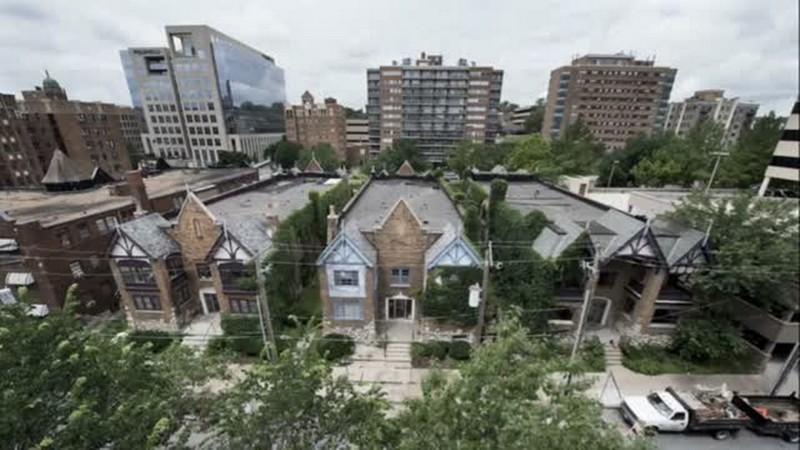
Backstory and Context
Text-to-speech Audio
Between 1927 and 1929, Nelle E. Peters was commissioned to design these six apartment buildings by Charles Phillips of Phillips Building Company, a relationship that dates back to 1913. The height of Peter's career was during the 1920s as Kansas City began growing rapidly. During this time, the concept of multiple dwelling units had been established as a fundamental type of housing for the city. Peters was one of the architects who pioneered them. She designed nearly 1,000 buildings in her career, many of which were apartments and hotels, and a large number of the structures were constructed by Phillips. The landscape of suburban Kansas City was shaped by the Peters-Phillips partnership.
Peters became known for quickly producing simple yet functional designs. She often designed in Spanish Colonial and Tudor style, using similar materials and concepts with highly efficient floorplans. In a 1925 interview with the Kansas City Journal, Peters remarked, “I want each building to be as perfect, as economical and practical as if I were building it for myself.” Many of her buildings contained unified architectural elements including brick construction and terra cotta ornamentation. She also favored columns, porches, and courtyards when possible.
The success of the Country Club Plaza, first opening in 1923, also attracted patrons and residents to this area, creating a need for larger apartment buildings. In addition to many other buildings in the Plaza area, this historic district contains thirteen apartment buildings in total, however, just six of them were included in the nomination for the Kansas City Register of Historic Places. The Nelle E. Peters Thematic Historic District was accepted on August 27, 1989, and includes the buildings Cezanne; Cottesbrook; David Copperfield; Rosseau; Vanity Fair; and Washington Irving. As an admirer of the arts, Peters named each of these buildings after famous figures and notable references from arts and literature. The district is commonly known as the “Literary Block”, “Literary Row”, “Poets District”, or “Poets and Painters”. Like many of Peter’s designs, this group of buildings offers a unified urban streetscape constructed with stylistic variety using brown variegated brick and terracotta ornamentation, paired facades, and inter-related courtyards.
David Copperfield (804 W 48th Street)
First published in series in 1849-1850 and then in book form in 1850, David Copperfield is a semi-autobiographical novel written by British novelist Charles Dickens. Charles Dickens (1812-1870) is considered by many to be the greatest writer of the Victorian period. At age 15 he worked as a reporter before starting his writing career in fiction. He had a great ability to spin a story in an entertaining way and the power of character creation. His work is characterized by using pathos, contains a macabre and pervasive spirit, and uses a highly inventive prose style. The story of David Copperfield reflects many of Dickens’ early life experiences, such as his education and working in a factory at a young age, evoking the thought and nature of memory itself. His other famous works include Oliver Twist (1838), A Christmas Carol (1843), and A Tale of Two Cities (1859).
This 3-story “L” shaped apartment building was constructed in 1927 in a Tudor style motif. It features projecting stucco and half-timber bays, a conical tower, roof parapets, trip-parte multi-paned casement windows, a crenelated roofline, and stone string course and coping detail.
Cezanne and Rosseau (712 and 720 W 48th Street)
Paul Cezanne (1839-1906) was a French painter who worked in the Impressionist style. He often emphasized the structure of objects, making compositions of cubic masses and patches of color, and was an inspiration for the Cubist artists Pablo Picasso and Georges Braque.
Jean-Jacques Rousseau (1712-1778) was a Swiss born-French philosopher. He started writing on music and economics, later evolving into discourses of society. He believed in the natural good in man but that organized society reinforced inequity, as seen in works like The Discourse on the Origin and Foundations of Inequality Among Men (1754). Also writing music, Rousseau’s opera The Cunning-Man (1752) was widely admired.
These two, 5-story apartment buildings mirror each other in design and are often named together as their “L” shapes encompass a common courtyard. The Cezanne was built in 1927 and the Rousseau in 1929. They feature polychrome terracotta detail in Art Deco floral and geometric motifs along with terracotta panels that are interspersed within the parquet brickwork.
Washington Irving (4746 Roanoke Parkway)
New York-born writer Washington Irving (1783-1859) is called the “first American man of letters''. He started his career as a lawyer but became a leader for a group that published a whimsical periodical, Salmagundi (1807-1808). He is best known for two of his short stories Legend of Sleepy Hollow and Rip Van Winkle, which are from a collection of satirical essays called, “The Sketch Book of Geoffrey Crayon, Gent'' (1819–20). They are both Americanized versions of German folktales. During the 1940s, Irving served as an American ambassador to Spain.
Built in 1928, this 7-story apartment building was constructed in a modified “L” shape. It features an undulated facade with string course brick detail, a tower with a hipped clay tile roof and round arches, and rope-like columns at the entrance. Terracotta ornamentation is used above the door and round-arched windows at the roofline, and in the panels that mark the bays' spandrels.
Vanity Fair (700 W 48th Street)
Commonly known as an American magazine and a novel by William Thackeray, Vanity Fair was first introduced in an allegorical story called “Pilgrim’s Progress” by John Bunyan in 1678. In this story, Vanity Fair was a stop along the pilgrim’s route which featured a never-ending fair held in the town called Vanity. The interpretation encompasses the definition of vanity.
The first publication of Vanity Fair by Thackeray was released in a series of installments in 1847 to 1848. Subtitled “Pen and Pencil Sketches of English Society”, the series included illustrations and sketches by Thackeray. It was published in book form in 1848 and subtitled “A Novel without a Hero”, reflecting his interest in deconstructing the conventions behind literary heroism. The setting took place in England during the Napoleonic War era and is a satirical story of interwoven fortunes of two women with contrasting personalities, which are based on their reactions to life and positions within the English society. It has been the inspiration for several motion pictures.
William Makepeace Thackeray (1811-1863) was a novelist from London, England. First studying law and art, he quickly became a prolific writer publishing periodicals and novels. He was regarded as the only rival of Charles Dickens at the time. He often used pen names including Mr. Michael Angelo Titmarsh, Fitz-Boodle, The Fat Contributor, and Ikey Solomons. His fame stemmed from Vanity Fair, which was his first work not published in a pseudonym.
Vanity Fair as a magazine was first released weekly in Manhattan, New York between 1859-1863. It was then picked up as a British satirical magazine in 1868 to 1914 and an American theatre magazine in 1890. After being purchased in 1913, Dress and Vanity Fair was launched as a hybrid magazine but was unsuccessful. Vanity Fair was reintroduced in 1914 and became a cultural force during the Jazz Age, publishing work of modern artists, illustrators, and writers, as well as popularized celebrity portraiture. It merged with Vogue in 1936 and relaunched as its own entity in 1983.
This 3-story English cottage-style building was constructed in 1927. It features projecting bays, soldier course brick lintels, stucco and half-timber gables, stone sill windows, a crenelated roofline, and terra cotta panels.
Cottesbrook (708 W 48th Street)
Cottesbrooke is a small village in Northamptonshire, England. It is claimed by many to be the model for Jane Austen’s 1814 novel, Mansfield Park. A historical estate in Cottesbrooke was purchased in 1635 by the Langham baronets, a family of London turkey merchants, and contains 13 acres of gardens, fields, and wooded areas. Cottesbrooke Hall, a picturesque Queen Anne-style home built on the estate in 1702 for Sir John Langham, the 4th Baronet, was possibly the inspiration for many of Nelle Peters’ designs. It features rose-colored brickwork, Corinthian pilasters, and entablature made of Ketton stone.
Jane Austen (1775-1817) was a remarkable English novelist. She was primarily homeschooled, and with the influence of her father's extensive library began writing comics at a young age. Her work transitioned to mature fiction, creating unfinished work that would not be published until after her death. Austen chose to be an anonymous author and published four novels during her lifetime. Her last two novels were published posthumously by her family, which finally acknowledged her as the author. Mansfield Park was her third novel, following Sense and Sensibility (1811) and Pride and Prejudice (1813). Her work is known for its satirical irony to social hypocrisy and gentry in 18th century English society.
The 3-story Tudor style apartments were built in 1927. It features two projecting bays featuring porches, stucco and half-timber gables, and carved brackets that support scalloped bargeboards. In addition, ornate terracotta chimney pots crown the crenellated roofline and a terracotta arch adorned with incised floral panels crowns the main entrance.
The following are the other apartment buildings in this district that are not included on the historic register:
Mark Twain (1929) - 4801 Roanoke Parkway
Robert Browning (1929) - 4809 Roanoke Parkway
Thomas Carlyle (1928) - 700 Ward Parkway
James Russell Lowell (1929) - 722 Ward Parkway
Henry Wadsworth Longfellow (1928) - 4800 Jefferson Street
Robert Louis Stevenson (1928) - 4804 Jefferson Street
Eugene Field (1929) - 807 W 48th Street
In June 2015, after all the occupants had been vacated, city permit records revealed an indication for the intent to demolish a set of three Peters’ buildings located less than a block north of this historic district, at 4728, 4730, and 4734 Summit Street. Though the buildings had fallen into some disrepair, in an effort to save them, Historic Kansas City filed an application to add them to this registered Thematic Historic District. They were overwhelmingly approved by both the Historic Preservation Commission and the City Planning Commission. However, in a final decision, the City Council’s Planning, Zoning and Economic Development Committee voted to deny the building's historic status because they fell outside of the district's boundary. This decision, paired with the state of the buildings and the economic value of this prime real estate led to their demolition and the construction of new buildings.
Sources
Nelle E. Peters, Historic Missourians. Accessed February 4th 2022. https://historicmissourians.shsmo.org/nelle-peters.
Kansas City Landmarks Commission. "Nelle E. Peters Thematic Group." Administrator's Report. Case No 0124-D Exhibit E.
Kansas City Register of Historic Places by Address, City of Kansas City, Missouri. October 25th 2017. Accessed February 4th 2022. https://www.kcmo.gov/home/showpublisheddocument/7054/637684321527600000.
midtownkcposter. Nordstrom Block Has Seen Changes Before, Midtown KC Post. January 7th 2020. Accessed February 4th 2022. http://midtownkcpost.com/plazas-nordstrom-block-has-seen-changes-before/.
4728-4744 Summit, Historic Kansas City. Accessed February 4th 2022. https://www.historickansascity.org/historic/4728-4734-summit/.
Biography Washington Irving, Encyclopedia Britannica. Accessed February 4th 2022. https://www.britannica.com/biography/Washington-Irving.
Vanity Fair, Encyclopedia Britannica. Accessed February 4th 2022. https://www.britannica.com/topic/Vanity-Fair.
Vanity Fair American Magazine, Encyclopedia Britannica. Accessed February 4th 2022. https://www.britannica.com/topic/Vanity-Fair-American-magazine.
The Hall, Cottesbrooke Hall & Gardens. Accessed February 4th 2022. https://www.cottesbrooke.co.uk/hall/.
Jane Austen, Wikipedia. Accessed February 4th 2022. https://en.wikipedia.org/wiki/Jane_Austen.
Paul Cezanne, Encyclopedia Britannica. Accessed February 4th 2022. https://www.britannica.com/biography/Paul-Cezanne.
Jean-Jacques Rousseau, Encyclopedia Britannica. Accessed February 4th 2022. https://www.britannica.com/biography/Jean-Jacques-Rousseau.
Charles Dickens, Encyclopedia Britannica. Accessed February 4th 2022. https://www.britannica.com/biography/Charles-Dickens-British-novelist.
https://pioneeringwomen.bwaf.org/nelle-elizabeth-peters/
https://www.forrent.com/mo/kansas-city/braemar-apartments/qhppgtz
https://rmgkc.com/communities/plaza-apartment-center/cezanne-apartments-resource-management-group-4/
https://kchistory.org/image/cezanne-apartments?solr_nav%5Bid%5D=ed58f14d550f764df11e&solr_nav%5Bpage%5D=0&solr_nav%5Boffset%5D=14
http://midtownkcpost.com/plazas-nordstrom-block-has-seen-changes-before/
https://kchistory.org/image/washington-irving-apartment-building?solr_nav%5Bid%5D=d024545be85e5dbd1af2&solr_nav%5Bpage%5D=0&solr_nav%5Boffset%5D=0
https://www.trulia.com/p/mo/kansas-city/700-w-48th-st-101-102-kansas-city-mo-64112--2554758151
https://kchistory.org/image/sanborn-map-kansas-city-vol-6-1917-1945-page-p796?solr_nav%5Bid%5D=4592c7da32a1aef8d433&solr_nav%5Bpage%5D=0&solr_nav%5Boffset%5D=0
https://kchistory.org/image/sanborn-map-kansas-city-vol-6-1917-1945-page-p797?solr_nav%5Bid%5D=4592c7da32a1aef8d433&solr_nav%5Bpage%5D=0&solr_nav%5Boffset%5D=1
https://pioneeringwomen.bwaf.org/nelle-elizabeth-peters/
Kansas City Star via google image search
